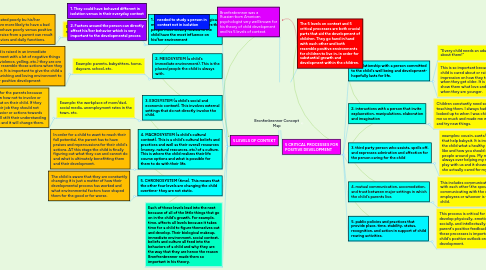
1. 5 LEVELS OF CONTEXT
1.1. 1. MICROSYSTEM (a child's biological makeup). This is the system where the people most closely related to the child have the most influence on his/her environment
1.1.1. Example: parents, teachers, babysitters, neighbors, etc.
1.1.1.1. If a child is treated poorly bu his/her mother they are more likely to have a bad reaction and behave poorly versus positive feedback or praise from a parent can result in better behaviors and daily functions.
1.2. 2. MESOSYSTEM (a child's immediate environment). This is the places/people the child is always with.
1.2.1. Example: parents, babysitters, home, daycare, school, etc.
1.2.1.1. If a child is raised in an immediate environment with a lot of negative things (drugs, violence, yelling, etc.) they are ore likely to resemble those actions when they get older. It is important to give the child a very nourishing and loving environment to aid their positive development
1.3. 3. EXOSYSTEM (a child's social and economic context). This involves external settings that do not directly involve the child.
1.3.1. Example: the workplace of mom/dad, social media, unemployment rates in the town, etc.
1.3.1.1. This is important for the parents because they need to know how not to involve or take something out on their child. If they got fired from their job they should not change their behavior or actions towards their child or it will stilt their understanding of their behaviors and it will change them.
1.4. 4. MACROSYSTEM (a child's cultural context). This is a child's cultural beliefs and practices and well as their overall resources (money, natural resources, etc) of a culture. This is where the child realizes their life course options and what is possible for them to do with their life.
1.4.1. In order for a child to want to reach their full potential, the parent has to have praises and repercussions for their child's actions. AT this stage the child is finally figuring out what they can and cannot do and what is ultimately benefitting them and their development.
1.5. 5. CHRONOSYSTEM (time). This means that the other four levels are changing the child overtime- they are not static.
1.5.1. The child is aware that they are constantly changing it is just a matter of how their developmental process has worked and what environmental factors have shaped them for the good or for worse.
1.6. Each of these levels lead into the next because of all of the little things that go on in the child's growth. For example, time, affects all levels because it takes time for a child to figure themselves out and develop. Their biological makeup, immediate environment, social context, beliefs and culture all feed into the behaviors of a child and why they are the way that they are hence the reason Bronfrenbrenner made them so important in his theory.
2. Bronfenbrenner was a Russian-born American psychologist very well known for his theory of child development and his 5 levels of context.
2.1. needed to study a person in context not in isolation
2.1.1. 1. They could have behaved different in isolation versus in their everyday context
2.1.2. 2. Factors around the person can directly affect his/her behavior which is very important to the developmental proces
3. 5 CRITICAL PROCESSES FOR POSITIVE DEVELOPMENT
3.1. 1. A relationship with a person committed to the child's well being and development- hopefully lasts for life.
3.1.1. "Every child needs an adult that is crazy about them!"
3.1.2. This is so important because the way a child is cared about or raised has a lasting impression on how they tend to behave when they get older. It is important to show them what love and care means when they are younger.
3.2. 2. interactions with a person that invite explaoration, manipulations, elaboration and imagination
3.2.1. Children constantly need someone who is teaching them. I always had someone I looked up to when I was child that taught me so much and made me want to explore and try new things.
3.3. 3. third party person who assists, spells off, and expresses admiration and affection for the person caring for the child
3.3.1. examples: cousin, aunts/uncles, friends that help babysit. It is important to show the child what a healthy relationship looks like and how you should care for the people around you. My mom's cousin was always over helping my mom watch us or play with us and it showed me how much she actually cared for my mom.
3.4. 4. mutual communication, accomodation, and trust between major settings in which the child's parents live.
3.4.1. This includes communicating effectively with each other (the spouses) as well as communicating with the daycare employees or whoever is watching the child.
3.5. 5. public policies and practices that provide place, time, stability, status, recognition, and action in support of child rearing activities.
3.5.1. This process is critical for the child to develop physically, emotionally, socially, and intellectually. The parent's positive feedback during these processes is important for the child's positive outlook on their development.

